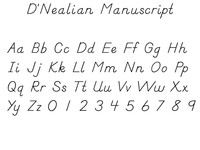
D'Nealian
Encyclopedia

Cursive
Cursive, also known as joined-up writing, joint writing, or running writing, is any style of handwriting in which the symbols of the language are written in a simplified and/or flowing manner, generally for the purpose of making writing easier or faster...
and print (block) handwriting
Handwriting
Handwriting is a person's particular & individual style of writing with pen or pencil, which contrasts with "Hand" which is an impersonal and formalised writing style in several historical varieties...
for English
English language
English is a West Germanic language that arose in the Anglo-Saxon kingdoms of England and spread into what was to become south-east Scotland under the influence of the Anglian medieval kingdom of Northumbria...
(and perhaps other languages written with the Latin alphabet
Latin alphabet
The Latin alphabet, also called the Roman alphabet, is the most recognized alphabet used in the world today. It evolved from a western variety of the Greek alphabet called the Cumaean alphabet, which was adopted and modified by the Etruscans who ruled early Rome...
). It was designed to ease the learning of cursive and print handwriting. It was developed by Donald Thurber, who developed the system while teaching in a primary school, and was first introduced in 1978. The name of the script comes from Donald's first name contracted with his middle name ("Neal").
The system was designed as a method to alleviate the problems with teaching children the standard Zaner-Bloser Script method and the subsequent difficulty transitioning to cursive
Cursive
Cursive, also known as joined-up writing, joint writing, or running writing, is any style of handwriting in which the symbols of the language are written in a simplified and/or flowing manner, generally for the purpose of making writing easier or faster...
writing. D'Nealian manuscript form has many similarities to the cursive version. In theory, it is easier for children to learn and acquire basic handwriting skills using this method than traditional cursive writing.

Criticism
D'Nealian has drawn criticism in many locations, as the addition of so-called "monkey tails" to manuscript effectively adds a "third step" to how children are instructed to write. Moreover, a common issue is that D'Nealian is taught extremely early, to firstFirst grade
First grade is a year of primary education in schools in the United States and English-speaking provinces of Canada. It is the first school year after kindergarten...
and second grade
Second grade
In the United States, second grade is a year of primary education. Second grade is the second school year after kindergarten. Students are traditionally 7–8 years old, depending on when their birthday occurs....
students, many of whom are still learning the rudiments of print-style writing. At times, some school districts have abruptly changed their teaching of handwriting, possibly causing difficulties for students who must then adapt to a different style. In many schools, this style is taught in place of block-print and so the child never learns how to print.
A research review by Steve Graham (1993/94) concludes that "there is no credible evidence" that D'Nealian makes a difference in children's handwriting, that D'Nealian creates practical problems for teachers (who must themselves learn the system and defend it to parents), and that it requires many young children to unlearn writing forms that they have already developed before formal instruction.

